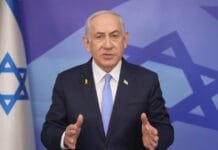Israel has escalated its military response against Hezbollah following the death of Hassan Nasrallah, Hezbollah’s chief, deploying tanks near the Lebanon border on Sunday. The move signals Israel’s intent to intensify its operations in the region. Al Jazeera released photographs showing Israeli tanks stationed close to the border, amplifying concerns of a broader conflict.
Meanwhile, the U.S. Department of Defense has acknowledged that it was aware of the strike on Nasrallah, with Israel informing the United States before fighter planes were deployed for the operation. Israel claims it sent a clear message to the U.S. before the attack commenced. However, despite Nasrallah’s death, Israel’s airstrikes in Lebanon have persisted.
Continuing Airstrikes Result in Heavy Casualties
Despite the killing of Hassan Nasrallah, Israel did not ease its military campaign. On Saturday, airstrikes continued across Lebanon. The Lebanese Health Ministry reported that 33 people were killed in the latest round of attacks, with 195 others injured. These strikes have further destabilized the region, leading to heightened concerns over civilian casualties and the worsening humanitarian situation.
In addition to targeting Hezbollah leadership, Israel claimed the elimination of several prominent figures within the group. Among the fatalities was Hassan Khalil Yassin, a senior Hezbollah commander, and Sheikh Nabil Kaouk, another top leader. Hezbollah has yet to officially confirm Kaouk’s death, though several condolence messages for him have emerged from Hezbollah supporters.
The Death of Senior Commander Hassan Khalil Yassin
The Israeli Defense Forces (IDF) stated that Hassan Khalil Yassin, one of Hezbollah’s top commanders, was leading critical operations within the group’s intelligence unit. Yassin’s role was vital in orchestrating attacks against Israel, according to the IDF, which reported that Yassin had been working closely with Hezbollah’s missile and drone units. He was directly involved in planning terrorist attacks aimed at both Israeli civilians and soldiers, making him a key figure in Hezbollah’s military strategies.
Israel’s targeted killing of Yassin marks a significant blow to Hezbollah’s operational capabilities. According to the IDF, Yassin was in the midst of planning further attacks on Israeli targets in the coming days, underscoring the threat he posed to the Jewish state.
Impact of Hezbollah Leadership Loss on the Conflict
The loss of Hassan Nasrallah and senior commander Hassan Khalil Yassin could significantly weaken Hezbollah’s organizational structure. Nasrallah had long been a figurehead of resistance against Israel, and his death creates a power vacuum within Hezbollah’s upper ranks. With both Nasrallah and Yassin gone, Hezbollah’s future operational strategies and internal cohesion remain uncertain.
Nonetheless, Hezbollah has a history of resilience, and its leadership has previously shown the ability to regroup and continue its campaigns against Israel despite the loss of key figures. The ongoing airstrikes and ground deployments by Israel near Lebanon’s border suggest that the conflict will not subside in the immediate future.
A Broader Regional Implication
The continued military operations between Israel and Hezbollah risk escalating the conflict into a broader regional crisis. With Israel fortifying its border with tanks and continuing airstrikes, the potential for further international involvement grows. The United States’ awareness of the situation and Israel’s communication with them before launching strikes highlights the international dimension of the conflict.
Hezbollah’s deep-rooted connections with Iran and its strategic position in Lebanon make the situation highly volatile. Should Hezbollah retaliate more aggressively, it could draw neighboring nations or other regional powers into the conflict. This could destabilize the broader Middle East, increasing the potential for widespread military confrontations.
Future Outlook: Ongoing Conflict and Uncertainty
With the deaths of prominent Hezbollah leaders and the continued Israeli airstrikes, the conflict shows no signs of resolution. The loss of key Hezbollah commanders has only added fuel to the fire, with both sides unwilling to back down. Israel’s decision to deploy tanks to its northern border suggests that it is prepared for any retaliation from Hezbollah, and the airstrikes indicate that further military operations are likely.
The world watches closely as tensions between Israel and Hezbollah intensify, and while the future remains uncertain, it is clear that the conflict has reached a dangerous tipping point. The death of Hassan Nasrallah may have removed one of Hezbollah’s most influential figures, but the cycle of violence continues with no immediate end in sight. Both sides remain entrenched in a struggle that has far-reaching consequences for the entire region.
















